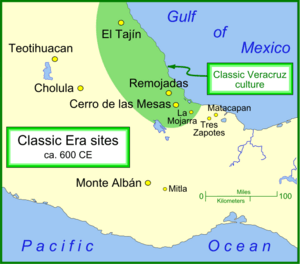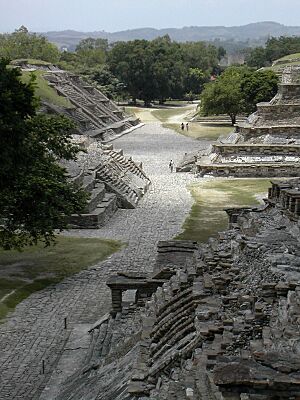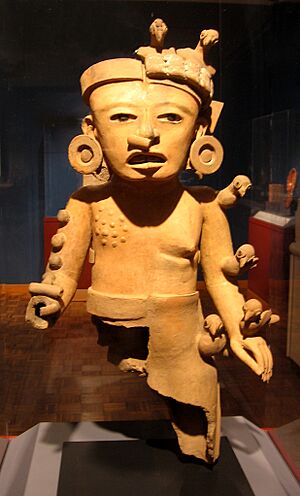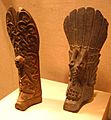Classic Veracruz culture facts for kids
The Classic Veracruz culture was an ancient civilization that lived in the central and northern parts of what is now the Mexican state of Veracruz. This culture existed from about 100 CE to 1000 CE. This time period is known as the Classic era in Mesoamerican history.
El Tajin was the most important city of the Classic Veracruz culture. Other significant places included Higueras, Zapotal, Cerro de las Mesas, Nopiloa, and Remojadas. The last two were famous for making pottery. This culture stretched along the Gulf Coast of Mexico, from the Pánuco River in the north to the Papaloapan River in the south.
Sometimes, the Classic Veracruz culture is linked to the Totonac people. The Totonacs lived in this area when the Spanish arrived in Mexico. However, there is not much proof that the Totonacs started the Classic era culture.
Contents
How Classic Veracruz Society Was Organized
By studying burials, large sculptures, carvings, and how buildings were arranged in their cities, we can learn about the Classic Veracruz society. It was a society with different levels, meaning some people had more power than others. There were important leaders, called the elite, and also people who specialized in making crafts.
These powerful leaders ruled over small to medium-sized cities. They kept their power by controlling trade routes and through religious practices. These practices included important Mesoamerican traditions like bloodletting and warfare. Most people, however, lived in small homes, hamlets, or villages.
Like the Epi-Olmec culture and Olmec cultures before them, the Classic Veracruz people grew their food using a method called slash-and-burn agriculture. Corn was a very important part of their diet. They also ate domestic dogs, wild deer, other mammals, fish, and shellfish. Cotton was another important crop they grew.
Religion and Beliefs
We do not know a lot about the religion of the Classic Veracruz culture. We often have to guess based on other Mesoamerican religions, like those of the Aztec, Mixtec, and Maya. Only a few gods from their religion have been clearly identified.
Large pottery figures show an old, bent man who represents the Mesoamerican fire god. Other big pottery statues show female earth goddesses. These goddesses have snake belts and are linked to the site of El Zapotal. Some of these figures have closed eyes and open mouths. Because of this, and because a shrine to a death god was found nearby, some think these figures represent women who died during childbirth.
The carvings on the ball courts at El Tajin show a death god, a rain god, and possibly a sun god. These carvings tell stories, perhaps about how a drink called pulque was created. Stone objects called hachas often show the head of an old god, likely connected to earth and water. They also likely inherited an earth monster belief from the Olmecs. Many pottery figures dressed for ceremonies have been found. This shows how important public rituals were. Pottery figures with smiling faces, called sonrientes, might represent people performing these rituals.
The Mesoamerican Ballgame

The Classic Veracruz culture seemed to love the Mesoamerican ball game. Every major cultural center had at least one ballcourt. At El Tajin, archaeologists have found up to 18 ballcourts! The ballgame became most popular in this region during the Late Classic period.
A special feature of the Classic Veracruz culture is the stone equipment used for the ballgame. This included yokes, hachas, and palmas. Yokes were U-shaped stones worn around a player's waist. Hachas and palmas were placed on top of the yoke.
Palmas were long sculptures, often shaped like birds such as turkeys, or showing realistic scenes. They were attached to the front of a yoke. Hachas were thin stone heads. They were usually markers used to score the game, but could also be worn on the yoke. Archaeologists believe these stone yokes were special versions of yokes made from leather, cotton, or wood. However, no such older, perishable items have been found. While yokes and hachas have been found in many places, palmas seem to be unique to the northern Veracruz area.
Art of Classic Veracruz
The art of Classic Veracruz is known for its detailed and swirling patterns, called scrolls. These scrolls can be seen on large buildings and on smaller items like pottery and carved bones. Some researchers think that the heads and other shapes formed by these scrolls might be a type of picture writing. This scroll design might have developed from similar styles found in places like Chiapa de Corzo and Kaminaljuyu.
Besides the scrollwork, the buildings are famous for their amazing decorations. A great example is the Pyramid of Niches at El Tajin. These decorations create strong contrasts of light and shadow, which an art historian named George Kubler called "bold chiaroscuro" (meaning strong light and shadow effects).
While the Classic Veracruz culture was influenced by Teotihuacán and the Maya, it did not directly come from them. Instead, this culture seems to have grown from earlier Epi-Olmec culture centers, such as Cerro de las Mesas and La Mojarra.
Classic Veracruz Pottery
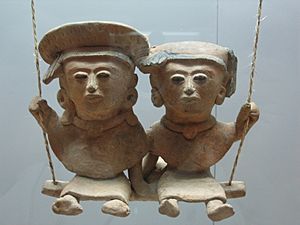
Before the 1950s, we knew very little about Classic Veracruz pottery. Most pieces found did not have clear origins. Since then, thousands of figurines and pottery pieces have been discovered from sites like Remojadas, Los Cerros, Dicha Tuerta, and Tenenexpan. Some were found by looters at first. These discoveries have greatly increased our knowledge and filled many museum displays.
Artist and art historian Miguel Covarrubias described Classic Veracruz pottery as "powerful and expressive." He said it had a charm and feeling not seen in other, more formal cultures.
Remojadas style figurines are perhaps the easiest to recognize. They were usually shaped by hand and often decorated with added pieces of clay, called appliqués. The Sonrientes (smiling faces) figurines are especially famous. They have triangular-shaped heads and arms stretched out. Nopiloa figurines are usually simpler, without appliqués, and often made using molds.
The Classic Veracruz culture also made some of the few wheeled figurines found in Mesoamerica. They were also known for using bitumen (a tar-like substance) to make parts of their pottery stand out.
Images for kids
See also
 In Spanish: Cultura del centro de Veracruz para niños
In Spanish: Cultura del centro de Veracruz para niños


